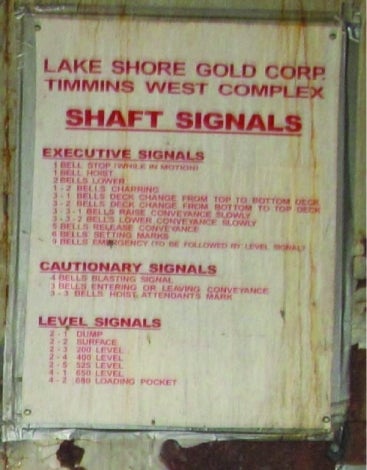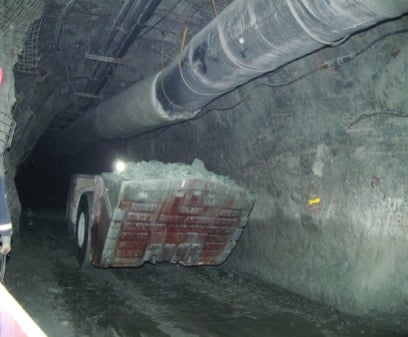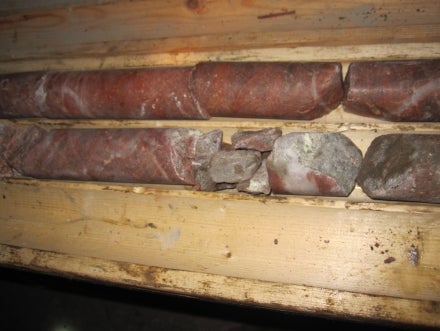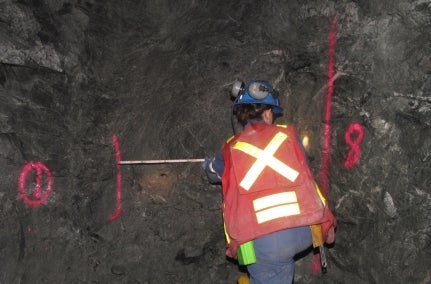Saturday, December 24, 2011
 What
on
Earth:
Volume
7
2011
What
on
Earth:
Volume
7
2011

After
studying
pictures
and
small
pieces
of
rocks
and
minerals
in
first
year
at
the
University
of
Waterloo,
I
finally
got
to
experience
the
practical
side
of
geology
this
summer
working
for
the
exploration
department
of
a
gold
company.
I
could
finally
see
firsthand
how
all
the
pieces
came
together;
each
little
bit
of
information
completing
the
puzzle
that
would
determine
the
company’s
path.
My
employment
began
in
May
at
Lake
Shore
Gold
Corp.
in
Timmins,
Ontario.
How
did
I
get
the
job?
I
have
networking
to
thank
for
that.
The
opportunity
actually
came
from
a
University
of
Waterloo
alumni
dinner
in
Timmins
that
I
attended.
It
turns
out
that
a
great
number
of
geologists
working
in
Timmins
are
from
University
of
Waterloo
(including
both
the
President/CEO
and
VP
of
Exploration
of
Lake
Shore);
earth
scientists
of
Waterloo
stay
strong!
Lake
Shore
also
gave
a
tour
of
their
Timmins
West
mine
to
us
university
visitors.
We
were
fortunate
to
learn
about
and
see
a
lot
of
the
mine’s
operations…
although
we
didn’t
quite
make
it
to
the
6:30am
geologists’
meeting
that
kicks
off
every
day
(even
in
exploration,
I
quickly
found
that
going
to
bed
early
was
a
virtue).

Signals and their meanings for working the mine elevator.
All
decked
out
in
our
boots,
coveralls,
and
hard
hats
complete
with
headlamps,
we
took
the
elevator
down
to
check
out
the
equipment
and
miners
at
work.
The
system
used
for
signaling
how
far
to
go
was
very
neat;
there
were
designated
codes,
each
consisting
of
varying
numbers
of
bells
and
pauses
between
them.
Every
area
had
a
different
series
of
bells.

Machine piled high with ore, at work in the mine.
When
we
got
in
the
mine,
there
were
endless
wide
tunnels
to
accommodate
all
of
the
large
(and
often
deafening)
heavy
equipment
trundling
around.
As
well
as
the
vehicles,
there
were
underground
diamond
drills
digging
up
valuable
core
from
right
inside
the
mine
to
be
logged.
There
were
geologists
working
too
of
course,
often
marking
intervals
to
be
sampled
on
the
tunnel
walls.

Box of core samples, waiting to be analyzed.
And
although
I
ended
up
working
in
the
exploration
office
instead
of
the
actual
mine,
the
dark
and
exotic
underground
atmosphere
did
have
a
certain
intriguing
appeal.
What
I
learned
from
my
time
in
exploration:
core
is
everything
(core
is
knowledge,
and
we
all
know
knowledge
is
power).
Core
from
surface
drills
out
in
the
field
and
underground
cores
already
in
the
mine
are
analyzed
faithfully
by
the
geologists
in
the
core
shacks.
They
record
the
geological
information
as
well
as
marking
samples
to
be
assayed
(which
determines
with
reasonable
accuracy
the
percentage
of
gold
in
the
material).
All
of
this
goes
into
the
database
which
is
used
to
produce
a
resource
block
model
(which
is
constantly
being
updated
as
new
information
is
gathered).
This
incorporates
the
lithologies
and
assay
figures
and
provides
the
basis
for
developmental
decisions.

A geologist, hard at work in the mine making measurements.
Of
course,
sometimes
a
lot
of
work
has
already
been
done
on
a
property
by
others
before
a
company
sets
up
a
mine!
Due
to
the
tremendous
price
of
gold,
some
properties
that
weren’t
worth
mining
before
have
a
lot
of
potential
now.
A
large
portion
of
my
job
was
to
compile
all
the
historical
log
and
assay
information
for
a
project
(that
other
companies
had
gathered
from
exploratory
drilling).
It
has
to
be
validated
of
course,
which
is
accomplished
through
re-running
some
of
the
old
samples
and
even
drilling
“twin”
holes.
That
was
another
part
of
my
job;
two
of
us
went
out
each
day
for
a
couple
of
weeks
to
take
a
look
at
old
core
from
historical
drillings.
We
would
bag
specific
old
samples
so
they
could
be
re-assayed
and
perform
specific
gravity
measurements
on
them
as
well.
Getting
to
that
work
was
not
always
quick
though!
Often
we
had
to
cut
down
brush
that
had
grown
around
the
core
farm
and
rig
up
a
tarp
when
it
was
raining
to
protect
us
(and
more
importantly,
our
equipment).
We
also
spent
a
few
days
marching
around
in
a
bug-infested
swamp
looking
for
and
marking
the
historical
drill
hole
sites
and
casings…
the
fun
part
of
the
summer!
In
truth
that
was
quite
enjoyable,
there
was
nothing
more
satisfying
than
finding
the
right
casing
after
slogging
around
for
an
hour
(assuming
the
hole
numbers
could
be
read,
which
wasn’t
as
often
as
ideal).
I
went
into
the
job
not
knowing
quite
what
to
expect,
but
I
enjoyed
all
of
it.
I
even
got
used
to
waking
up
at
5:30am!
(and
this
is
from
someone
who
would
sleep
in
past
1:00pm
every
chance
I
could).
I
know
for
certain
I
picked
the
perfect
career
for
me.
So
to
all
geologists,
rock
on!